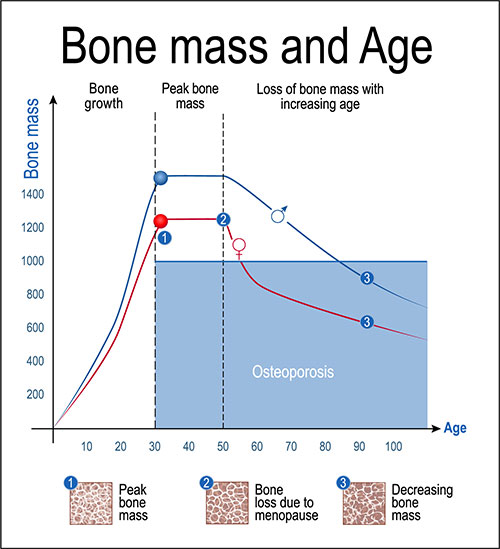 Contact
About Us
Articles
Home
Contact
About Us
Articles
Home

As a person ages, bones are at risk for becoming weaker. Most people reach peak bone mass by age 30. Thereafter, the body tends to lose more bone than it builds. In turn, weaker bones can lead to increased risk of fractures and can cause problems in mobility.
A condition known as osteoporosis, or a severe weakening of bones, can increase one’s risk of developing fractures since the bones become more brittle. This condition occurs when the body has a hard time creating new bone fast enough to replace bone lost.
Poor bone health can greatly impact a person’s life and make it difficult to function from day to day. In some cases, the results of a fall can lead to a person requiring home health or a nursing home.
The good news is that certain lifestyle behaviors and consuming certain nutrients can help reduce your risk of bone health issues. In the same way, consuming certain food and drink items or can increase your risk of weakened bones. It’s important to understand osteoporosis, ways to reduce your risk and which foods, supplements and behaviors can help you keep your bones healthy for years to come.
Osteoporosis is a silent bone disease that occurs when bone mineral density and bone mass decreases. This bone disease is the leading cause of fractures in postmenopausal women and older men, but it can happen to anyone at any age.
There are usually no symptoms of osteoporosis until someone falls and fractures occur. A bone scan would then be able to identify the weakening of bone and the ensuing diagnosis of osteoporosis. The most common bone scan is known as DEXA, or dual energy X-ray absorptiometry. It’s a quick and painless, non-invasive test that can tell your doctor your bone mineral density (BMD) and in turn your risk of osteoporosis.
The score to show your BMD is known as a T-score. If your T-score is -1 or greater than you have healthy bone density. A T-score between -2.5 and -1 indicates low bone density known as osteopenia. Finally, a T-score -2.5 or less indicates that you have osteoporosis, regardless of whether or not you have had a fracture or not yet.
Osteopenia impacts about half of Americans over the age of 50. Therefore, having bone scans done as you’re reaching this age can help identify any bone weakening and lower your risk of osteoporosis and bone fractures before they happen.
Factors that can place you more at risk for osteoporosis include:

Health experts suggest that most people receive their first bone scan around age 50 – or sooner if you have a history of frequent fractures.
As mentioned, by the age of 30, most people have reached their peak bone mass, and from there, your bones have an increased risk of weakening. Bone loss starts to occur faster than bone rebuilding, in turn weakening the structure of the bone.
However, besides just age, there are various factors that can increase one’s risk of weakening bone like:
Along with the above factors, certain lifestyle behaviors can impact bone health. These factors include:
Not being active on a regular basis can increase your risk of bone health issues. Research shows that too much sitting can lead to lower BMD levels. Moderate and vigorous intensity exercise however was found to have a protective effect on BMD.
Drinking alcohol in excess, more than one standard drink per day for most people, can harm the health of your liver and brain as well as bone health. One standard drink is equal to:
Research shows that consuming more than seven standard drinks a week is harmful for all aspects of health. Alcohol also can decrease calcium absorption in the body, which can harm bone health.
Smoking tobacco is not just harmful for your breathing, but also for your bones. Research shows that tobacco smoking can cause an imbalance in bone turnover, in turn lowering bone mass over time. Results show that once a person stops smoking, it can reverse the health effects of smoking, including improving bone health. Both firsthand and secondhand smoking can negatively impact bone health.
You may know that drinking sugary juices and colas often can lead to increased risk of various health issues like dental caries, cognitive issues and other chronic conditions. But did you know that drinking such beverages can also cause harm to bone health?
Research shows that the more sugar-sweetened and carbonated drinks that one consumes, the greater the impact it will have on lowering BMD. This is because various ingredients in such drinks like added sugar, phosphoric acid and caffeine can disturb calcium absorption and increase calcium excretion from the body.

The first thing you can do to help improve bone health is to change certain things in your eating routine by using the following tips.
Start with adding more calcium in your diet. You can add more calcium each day by eating foods like:
If you don’t consume enough of these foods in your daily diet, your doctor may recommend a calcium supplement. Most adults should consume about 1,000 milligrams of calcium daily to support bone health and reduce risk of fractures.
Replace carbonated colas and sugary juices with lower-sugar alternatives as well as plain water, tea and fruit-infused waters like lemonade instead. Also, add in milk or fortified plant-based milks for added calcium in your diet.
In order to help calcium absorb in the body well, you should also make sure you consume enough vitamin D daily since vitamin D assists calcium in absorption. There are not many foods that contain vitamin D except for fortified dairy products, fatty fish like salmon or fish, fortified cereals, and cod liver oil.
Therefore, if you don’t consume enough vitamin D through foods, you should take a vitamin D supplement as recommended by your doctor. Most adults need about 600 to 800 IU of vitamin D daily. You can also absorb vitamin D through 5 to 30 minutes of sunlight exposure at least twice weekly.
You should be sure to eat enough protein each day to help maintain lean muscle mass that will in turn help improve your mobility. Protein comes in many forms such as eggs, animal meats like beef, chicken, poultry, and pork, seafood, fish, tofu, beans, lentils, nuts, and seeds. Try to include a source of protein at each mealtime. Most adults should consume at least 1 gram of protein per kilogram of body weight.
For example, if someone weighs 150 pounds, then that would be around 68 kilograms. Therefore, that person should try to eat about 68 grams of protein each day. Common serving sizes of protein-rich foods include:
Besides changes in your diet, there are several lifestyle behavior changes you can make to help improve your bone health that include the following:
Weight-bearing exercises can help strengthen bones over time. Performing such exercises at least twice weekly for about 15 minutes can help support bone health. These type of exercises include:
Breathe regularly as you perform these exercises, and be sure to have someone close by for safety if you have an injury or are prone to falling. It can also help to perform flexibility exercises such as tai chi, yoga, and/or stretching to help reduce your risk of falling.
Be sure to visit your doctor at least once a year to have your labs tested for vitamin D and calcium levels, among other things. If you have a chronic disease like heart disease, diabetes, or osteoporosis, then you may have to visit the doctor more often to check on your progress. And if your calcium and vitamin D levels are low, then it would be of benefit to ask your doctor about having a DEXA scan done to assess your BMD. You should call your insurance company to make sure such a test is covered, and if not, to check to see how much it would cost out of pocket. Medicare Part B should cover a DEXA scan every so often as long as your doctor reports to the insurance company that it is essential for your health care.
Going to the doctor on a regular basis can also be a great time to ask about how any medicines you are taking could be impacting your bone health. Your local pharmacist could also answer such questions for you.
Sometimes we focus so much on heart health and brain health, that bone health becomes thrown by the wayside. However, bone health is vital to quality of life since your bones provide structure for your body that keeps you standing tall and moving around safely. And the health of your bones depends on so many things like how you eat, how you exercise and what lifestyle behaviors you engage in.
In order to best take care of your bone health, it may be helpful to contact your health insurance company to check and see if they cover certain tests that could provide baseline bone health measures. That is because DEXA scans and lab tests like calcium and vitamin D can tell you where your bone health status is now so you can take steps to improve it. It can also help to visit a registered dietitian to help you better choose foods daily to help you meet calcium intake goals.
Alliance America is an insurance and financial services company dedicated to the art of personal financial planning. Our financial professionals can assist you in maximizing your retirement resources and achieving your future goals. We have access to an array of products and services, all focused on helping you enjoy the retirement lifestyle you want and deserve. You can request a no-cost, no-obligation consultation by calling (833) 219-6884 today.


